s e l e c t e d w o r k
2 0 0 0 - 2 0 1 0 b y m a i a . e n g e . l i
2010
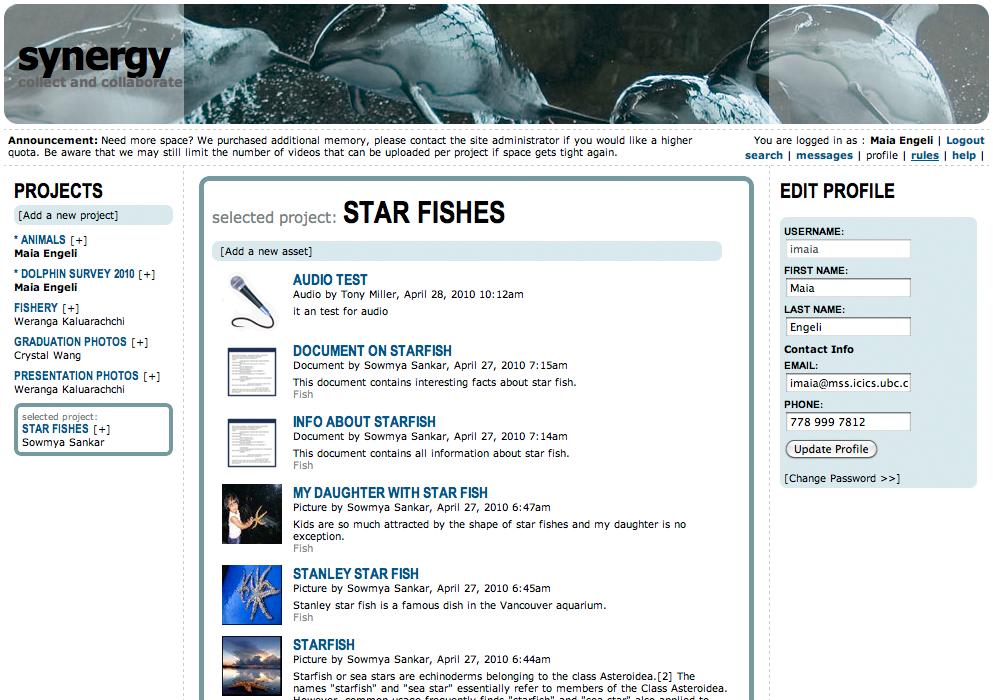
Synergy is a system to collect information and collaborate. Its primary role is to allow groups of users who work on the same project (journalists, researchers, scientists) to collect and share resources which include documents, photographs, videos and audio recordings. The system is private. User have to be signed up by the system administrator. Any user can create a project and include others as collaborators. The material of each project can only be seen by the collaborators on that project. There are search options and a messaging system. The system provides distinct interfaces for use via computer or mobile phone. Synergy is implemented on top of wordpress.
Team: Maia Engeli, Weranga Kaluarachchi, Crystal Wang, Sowmya Shankar, Jaspreet Deol
2009
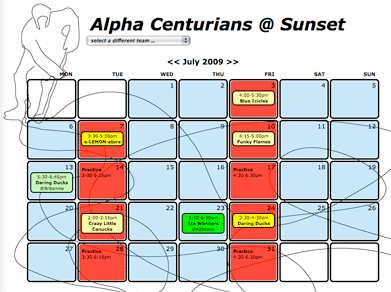
This system allows different little league teams to schedule their practice time as well games on their home ice. The interface provides a month by month view with the training days highlighted in red, games at home in yellow, games abroad in green, confirmed matches are brightly colored, non-confirmed ones have a light color. The ice mates home matches are displayed in black (confirmed) or gray (non-confirmed). There are 3 user groups: Kids and parents, team administrator, System manager.
Author: Maia Engeli
2009

This booking system for a car rental company was developed in Java using a Mysql database. The main functionalities include renting out cars, checking them back in, and managing the fleet. Different categories of cars are offered and extra equipment (child seat, bike racks) can be added. The company operates from a number of locations. The user interfaces were designed to give comprehensive guidance to the clerks.
Team: Maia Engeli, Humaira Tayyab, Michael Wang, Sowmya Shankar
2000-2005
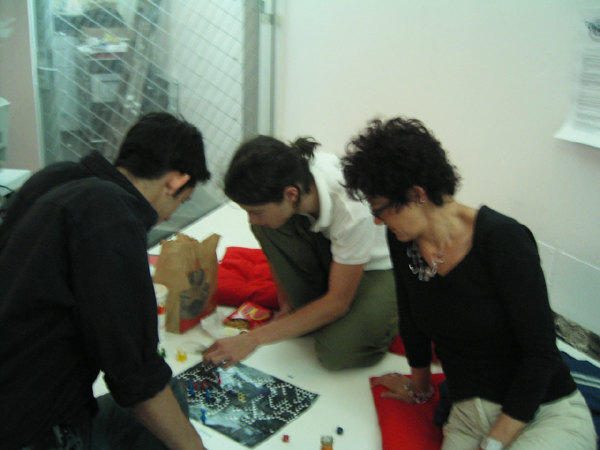
This is series of workshops I taught starting in 2000 building upon a strategy
of playful play with games for different learning effects. Games are first
of all made for gameplay, however, modifying games can add an interesting
creative aspect to it. Modifying a game or modding in short, lays somewhere
between just playing a game and creating a new game from scratch. Modding
includes the need to understand the essence game at hand and make conscious
decisions about the way to alter it.
Collaborators: Nina Czegledy, QS Serafijn, Miriam Zehnder, Eric van der Mark, Patrick Sibenaler, and Silke Lang
2003

Different aspects of Augmented Reality were examined in
this research project in a clearly defined studio situation from a design
and room perception point of view. A fully functional prototype in which different
scenarios can be shown was produced. The choreography is dependent on user
interactions in the real world (position and direction) and focuses on the
borderline between real and virtual worlds. The final artistic installation
will be used for further research towards a design vocabulary for Augmented
Reality, as an educational unit, as a showroom for exhibitions, and a tool
to further business partnerships.
Team: Maia Engeli, Jan Torpus, Roderick Galantay University of Art and Design, Basel. Sponsor: Swiss National Science Foundation. Partners: I-art Basel, Museum of Communication Bern, ETH Zurich.
2003
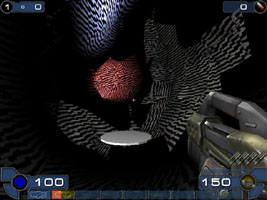
outside-inside-out
currently offline
With outside-inside-out we replaced the traditional multimedia
course at the Architecture Department at TU Delft, Netherlands. The aim was
to create a '3D-Multimedia' course. We worked with the modeling software
MAYA, a 3D printer und the game software Unreal Tournament and its editor
UnrealEd.
Team: Maia Engeli, Ernst Janssen Groesbeek,
Margit Tamas, Technical University Delft, The Netherlands
2001
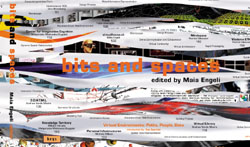
The motivation for this book comes from the wealth of projects
that have been realized at the Chair for Architecture and CAAD at the ETH
Zurich. Gerhard Schmitt was the head for 10 years from 1988 until 1998, when
he became Vice-President of the ETH Zurich and turned the direction of the
chair over to me. Our projects are visual and dynamic in nature. I decided
that we should present the most relevant ones in a book where images could
tell the main story and an accompanying CD would reveal their dynamic aspects.
The book consists of three parts: the BOOK, the MAP, and the CD. The underlying
design principle for all parts is the FLOW.
Authors: Gerhard Schmitt, Tom Sperlich, Rudi Stouffs, Fernando Burgos, Fabio Gramazio, Mikako Harada, Urs
Hirschberg, Kerstin Hoeger, David Kurmann, Eric van der Mark, Kuk Hwan Mieusset,
Michele Milano, Malgorzata Miskiewicz-Bugajski, Maria Papanikolaou, Marcin
Paszkowski, Patrick Sibenaler, Benjamin Staeger, Kai Strehlke and Andrew Vande
Moere, Arjan Dingste, Sigrun Gudjonsdottir, Alexandra Hoh, Bettina Klinge,
Martin Meier, Mark Rosa, and Miriam Zehnder
2001
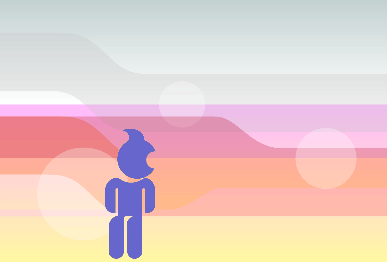
ETH World Mini-CDs
2 MiniCDs - "Vision and 14 Pioneer Projects" and
"Visions and Realities" - with gamelike interfaces to inform about
the ongoing ETH World projects.
Collaborators: Marcel Schneeberger, L'Altro visual graphic arts, Cyril Brunner and
Jakob Schiratzki,
Steffen Lemmerzahl,
Ida Schmieder,
streamix Lukas Gysling,
Eric van der Mark,
Anders Hagström and Barbara Meili,
Andrea Ventura and Alexandra Papadopoulos,
Michael O'Dell
2001
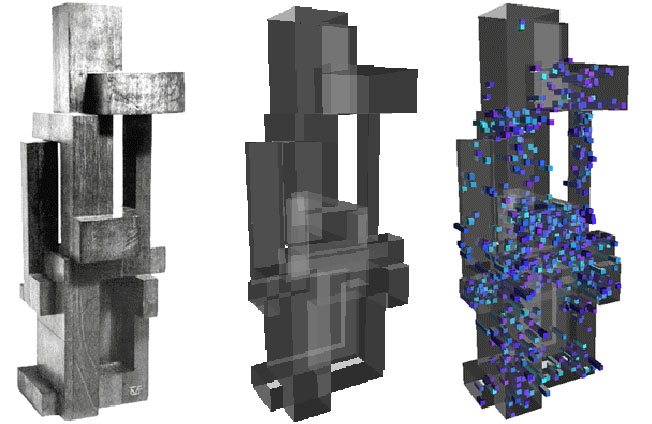
The goal of [roomz] was to teach students how to reveal architectonic ideas
with the computer by creating narrative scenarios in a three-dimensional environment.
Architectonic messages about space were formulated and then linked together
into one interconnected, dynamically-changing hyperstructure, which led to
the recognition that the stories themselves actually create the architecture
Team: Maia Engeli, Kai Strehlke, Fernando Burgos, Patrick Sibenaler, Maria
Papanikolaou, Cristina Besomi, Fabio Gramazio, Steffen Lemmerzahl, Miriam
Zehnder, Andrew Vande Moere, Mark Rosa
2000
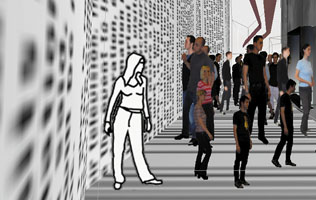
In a virtual reality environment we designed digital art installations to experiment with the
new possibilities of virtual architectural space. They were exhibited inside
various pre-defined rooms that functioned as dynamic containers exploring
various novel concepts of virtual reality as well as the real-time, interactive community life of the
exhibition environment itself.
Team: Maia Engeli, Andrew Vande Moere
2000
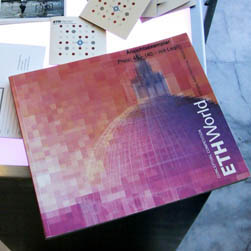
The open, two-stage-international competition was chosen as an effective instrument for arriving at a framework for the coordinated future development of ETH World in view of the rapidly developing possibilities and standards. Proposing this competition to an international field of participants was a natural consequence of the global aim of the ETH World vision. The goal was to obtain ideas and concepts for the master plan of ETH World, to sharpen understanding of the new challenges, and to find a broadly supported strategy. The collection of submissions opens a wide field of suggestions from which much can be learned. Elaborate ideas, when they are submitted to a competition, offer the possibility to compare and evaluate, and to reason about the goals of ETH World and how they could be achieved, based on proposals from a large number of expert teams.
The book is structured in three parts: It starts with a
text section containing an introduction by Prof. Kurt Forster, Professor of
the History of Art and Architecture at the ETH Zurich until 1999, Director
of the Centre Canadien d'Architecture, Montreal, and president of the ETH
World Jury. It is followed by thoughts from Prof. Gerhard Schmitt, Vice-President
for Planning and Logistics at the ETH Zurich, initiator of ETH World, and
member of the jury. The summary of the competition launch and process has
been compiled from documents created by the organizers and the jury. In part
two, the prize winners are presented, as well as additional submissions for
the second phase of the competition. These are followed in part three by the
submissions for the first phase.
Editors: Maia Engeli, Phillipe Carrard. Authors: Kurt Forster, Gerhard Schmitt, Maia Engeli, Walter Schaufelberger
2000
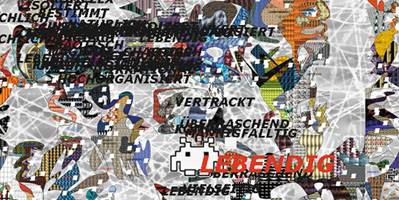
Dreamscape is an introductory information technology course
where students collectively design a visual landscape with links to information
in a web-based environment. The themes of system, communication, information,
and information architecture are explored in depth through lectures, exercises
and the building of the landscape, thereby helping students understand the
potential of IT and envision further developments.
Team: Maia Engeli, Malgorzata Miskiewicz-Bugajski, Mark
Rosa, André Müller, Andreas Weder, Patrick Sibenaler, Fabio Gramazio,
Maria Papanikolaou, Andrew Vande Moere, Cristina Besomi











